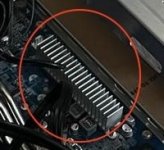I'm trying to help my friend fix an overheating problem with the voltage regulators, causing instability and crashes. We know improving airflow will resolve the problem, but I'm trying to find a way to improve overall dissipation capacity as well. Could I use a thermal adhesive to glue longer metal strips to each fin of this heatsink to improve its dissipation capacity? That seems easier than trying to remove the heatsink and install a larger unit onto the chips directly. Thoughts?
Attachments
Not sure you will get much. I can't tell, but am guessing the heat sink is inside the chassis. It is already a good sized heat sink, so am thinking the problem is no air flow thru the chassis so the sink and inside is getting hot. Where will the heat go?
Yes, this heatsink is inside the chassis, near an air vent, but doesn't get any active airflow. My friend was able to solve his crashing problems by taking the case off and putting a house fan next to it. I was hoping that with a larger heatsink, a smaller case fan could be mounted next to this heatsink, and an appropriate opening cut in the case panel, to allow sufficient cooling.
Is the issue that attaching new fins will not be as effective as if they were built in from the start?
Is the issue that attaching new fins will not be as effective as if they were built in from the start?
I'd start with the fan and cutting the vent. The primary reason to just add sink when you have as much as you have is passive cooling and then you are depending on natural convection and radiation cooling normally outside the chassis. Hafler does this with the DH-200. Pretty big sinks on the outside.
Even if you could attach heatsink extensions that would be extremely unlikely to triple the thermal efficiency. Even a small external low velocity fan moving a bit of air through the vents should double or triple the heat removal.
Of course the actual question is why is the heatsink that hot. What is the AC line voltage? It is much easier to use a buck transformer to provide a proper AC source voltage.
Of course the actual question is why is the heatsink that hot. What is the AC line voltage? It is much easier to use a buck transformer to provide a proper AC source voltage.
My friend is currently experimenting with smaller fans that can be integrated into the case, combined with expanded vent openings. I was thinking that a smaller fan combined with a larger heatsink would allow the thermal efficiency to "meet in the middle". Increasing heatsink size under a constant active airflow would still increase thermal dissipation, right?
The issue, I think, is that his CPU and general system configuration are over-stressing the voltage regulators of this motherboard. The "right" solution is to replace the board with a better one, but this is one of those cases where we're trying to make the best of what we have, hence the "hacks".
The issue, I think, is that his CPU and general system configuration are over-stressing the voltage regulators of this motherboard. The "right" solution is to replace the board with a better one, but this is one of those cases where we're trying to make the best of what we have, hence the "hacks".
I had that problem once about twenty years ago, I wound up finding another brand of computer that used the same components and had their own bios that mitigated the problem.
I have had great results using small 12vdc fans in similar situations.
I have had great results using small 12vdc fans in similar situations.
Have you tried replacing the thermal compound and reseating the device which creates the heat in the first place. Often the heat sink compound dries out and while I have never personally encountered a problem, I know it's usually a thing that gets done on a rebuild to ensure the power transistors survive.
Is that bare Al or anodized? Bare metal doesn't radiate heat effectively, painted or anodized does.
- Home
- Design & Build
- Construction Tips
- Stick-on fin extenders to improve heatsink performance?
